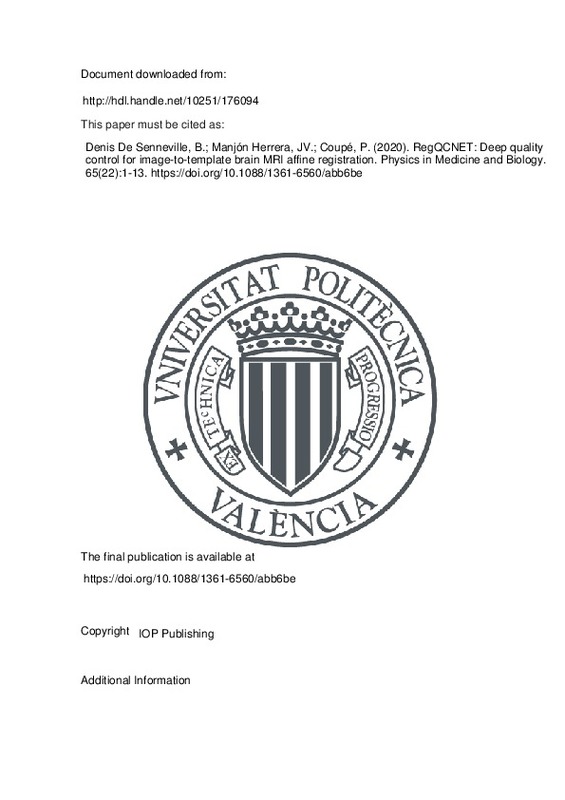JavaScript is disabled for your browser. Some features of this site may not work without it.
Buscar en RiuNet
Listar
Mi cuenta
Estadísticas
Ayuda RiuNet
Admin. UPV
RegQCNET: Deep quality control for image-to-template brain MRI affine registration
Mostrar el registro sencillo del ítem
Ficheros en el ítem
| dc.contributor.author | Denis de Senneville, Baudouin
|
es_ES |
| dc.contributor.author | Manjón Herrera, José Vicente
|
es_ES |
| dc.contributor.author | Coupé, Pierrick
|
es_ES |
| dc.date.accessioned | 2021-11-05T12:27:31Z | |
| dc.date.available | 2021-11-05T12:27:31Z | |
| dc.date.issued | 2020-11-21 | es_ES |
| dc.identifier.issn | 0031-9155 | es_ES |
| dc.identifier.uri | http://hdl.handle.net/10251/176094 | |
| dc.description.abstract | [EN] Affine registration of one or several brain image(s) onto a common reference space is a necessary prerequisite for many image processing tasks, such as brain segmentation or functional analysis. Manual assessment of registration quality is a tedious and time-consuming task, especially in studies comprising a large amount of data. Automated and reliable quality control (QC) becomes mandatory. Moreover, the computation time of the QC must be also compatible with the processing of massive datasets. Therefore, automated deep neural network approaches have emerged as a method of choice to automatically assess registration quality. In the current study, a compact 3D convolutional neural network, referred to as RegQCNET, is introduced to quantitatively predict the amplitude of an affine registration mismatch between a registered image and a reference template. This quantitative estimation of registration error is expressed using the metric unit system. Therefore, a meaningful task-specific threshold can be manually or automatically defined in order to distinguish between usable and non-usable images. The robustness of the proposed RegQCNET is first analyzed on lifespan brain images undergoing various simulated spatial transformations and intensity variations between training and testing. Secondly, the potential of RegQCNET to classify images as usable or non-usable is evaluated using both manual and automatic thresholds. During our experiments, automatic thresholds are estimated using several computer-assisted classification models (logistic regression, support vector machine, Naive Bayes and random forest) through cross-validation. To this end we use an expert's visual QC estimated on a lifespan cohort of 3953 brains. Finally, the RegQCNET accuracy is compared to usual image features such as image correlation coefficient and mutual information. The results show that the proposed deep learning QC is robust, fast and accurate at estimating affine registration error in the processing pipeline. | es_ES |
| dc.description.sponsorship | The experiments presented in this paper were carried out using the PlaFRIM experimental testbed, supported by Inria, CNRS (LABRI and IMB), Universite de Bordeaux, Bordeaux INP and Conseil Regional d'Aquitaine (see https://www.plafrim.fr/). This work benefited from the support of the project DeepvolBrain of the French National Research Agency (ANR-18-CE45-0013). This study was achieved within the context of the Laboratory of Excellence TRAIL ANR-10-LABX-57 for the BigDataBrain project. Moreover, we thank the Investments for the Future Program IdEx Bordeaux (ANR-10-IDEX-03-02, HL-MRI Project), the Cluster of Excellence CPU and the CNRS/INSERM for the DeepMultiBrain project. This study has been also supported by a DPI2017-87743-R grant from the Spanish Ministerio de Economia, Industria Competitividad. The authors gratefully acknowledge the support of NVIDIA Corporation with their donation of a TITAN X GPU used in this research. | es_ES |
| dc.language | Inglés | es_ES |
| dc.publisher | IOP Publishing | es_ES |
| dc.relation.ispartof | Physics in Medicine and Biology | es_ES |
| dc.rights | Reserva de todos los derechos | es_ES |
| dc.subject | Quality control | es_ES |
| dc.subject | Image-to-template registration | es_ES |
| dc.subject | Deep neural network | es_ES |
| dc.subject.classification | FISICA APLICADA | es_ES |
| dc.title | RegQCNET: Deep quality control for image-to-template brain MRI affine registration | es_ES |
| dc.type | Artículo | es_ES |
| dc.identifier.doi | 10.1088/1361-6560/abb6be | es_ES |
| dc.relation.projectID | info:eu-repo/grantAgreement/ANR//ANR-10-LABX-57/ | es_ES |
| dc.relation.projectID | info:eu-repo/grantAgreement/ANR//ANR-10-IDEX-03-02/ | es_ES |
| dc.relation.projectID | info:eu-repo/grantAgreement/ANR//ANR-18-CE45-0013/ | es_ES |
| dc.relation.projectID | info:eu-repo/grantAgreement/AEI//DPI2017-87743-R//DESARROLLO DE UNA PLATAFORMA ONLINE PARA EL ANALISIS ANATOMICO DEL CEREBRO TOLERANTE A LA PRESENCIA DE ALTERACIONES PATOLOGICAS/ | es_ES |
| dc.rights.accessRights | Abierto | es_ES |
| dc.contributor.affiliation | Universitat Politècnica de València. Departamento de Física Aplicada - Departament de Física Aplicada | es_ES |
| dc.description.bibliographicCitation | Denis De Senneville, B.; Manjón Herrera, JV.; Coupé, P. (2020). RegQCNET: Deep quality control for image-to-template brain MRI affine registration. Physics in Medicine and Biology. 65(22):1-13. https://doi.org/10.1088/1361-6560/abb6be | es_ES |
| dc.description.accrualMethod | S | es_ES |
| dc.relation.publisherversion | https://doi.org/10.1088/1361-6560/abb6be | es_ES |
| dc.description.upvformatpinicio | 1 | es_ES |
| dc.description.upvformatpfin | 13 | es_ES |
| dc.type.version | info:eu-repo/semantics/publishedVersion | es_ES |
| dc.description.volume | 65 | es_ES |
| dc.description.issue | 22 | es_ES |
| dc.identifier.pmid | 32906089 | es_ES |
| dc.relation.pasarela | S\433039 | es_ES |
| dc.contributor.funder | Nvidia | es_ES |
| dc.contributor.funder | Université de Bordeaux | es_ES |
| dc.contributor.funder | Agencia Estatal de Investigación | es_ES |
| dc.contributor.funder | Agence Nationale de la Recherche, Francia | es_ES |
| dc.contributor.funder | Centre National de la Recherche Scientifique, Francia | es_ES |







![[Cerrado]](/themes/UPV/images/candado.png)

